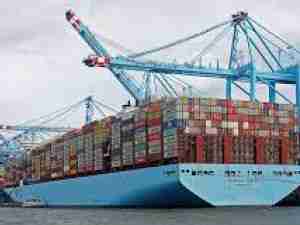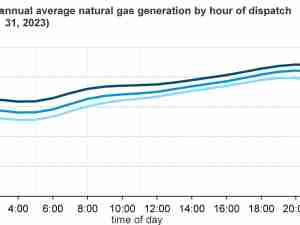Russia's seaborne crude exports jumped last week, with just days to go before the world's third-largest producer is due to cut output.
The country exported 3.6 million barrels a day from its ports in the seven days through Friday. That was a 26% hike in what are noisy weekly data. Flows climbed to multi-week highs from all its Baltic, Black Sea, Arctic and Pacific terminals. A less-volatile four-week average of exports also rose.
The flow data offer just the gentlest indication that a planned cut to Russian oil production from next month might not be forced. Moscow announced earlier this month that it would chop its March output by 500,000 barrels a day, a step that some analysts said was an unavoidable reduction and not a policy choice for Russia. The high rate of exports goes some way to undermining that argument.
The high level of crude being shipped out of Russia’s western ports, which now appears to include volumes previously piped to Poland and Germany, has left the country depending once more on European tankers to move its oil. The long voyages to carry cargoes to Asia mean that Russia’s own ships and the “shadow fleet” built up by Moscow-friendly companies can only load one lot every two months. As a result, an initial shift away from using European ships in the first month after European Union sanctions and a G-7 price cap were introduced couldn’t be sustained the following month.
The volume of crude on vessels heading to China and India — plus small flows to Turkiye and the quantities on ships that haven’t yet shown a final destination — rebounded in the four-week period, to an average 3.19 million barrels a day, equal to the highest amount observed since Bloomberg began tracking the shipments at the start of 2022.
Flows to China are little changed since before Russia invaded Ukraine almost a year ago. Historical patterns suggest that most of the cargoes currently identified as “Unknown Asia” or “Other Unknown” will end up in India.
Inflows to the Kremlin's war-chest from crude-export duties have plunged since the start of the year. While an easing of crude prices has played a part in that drop, so too has a widening gap between global benchmark Brent and reported prices for Russia’s key Urals grade, which are used to calculate tax rates.
Recent changes that will link oil tax rates in Russia to a discounted Brent price, rather than an assessed Urals value, will not apply to export duty. Export duty now plays a relatively minor role in Russia’s oil taxation, with mineral extraction tax and profit-based taxes on the industry becoming more important as part of a multi-year transition in the way the government earns revenue.
Ship-to-ship transfers of cargoes in the Mediterranean continue apace. This has been most visible off the Spanish north African city of Ceuta and off the Greek coast near Kalamata. At least 30 cargoes have been transferred between ships in those two locations since the start of the year. Twelve more Aframax tankers that loaded in the Baltic since late January look likely to transfer their cargoes to other vessels in the Mediterranean, based on their destination signals.
Crude Flows by Destination:
On a four-week average basis, overall seaborne exports rose by 129,000 barrels a day to 3.34 million barrels a day.
All figures exclude cargoes identified as Kazakhstan’s KEBCO grade. Those are shipments made by KazTransoil JSC that transit Russia for export through the Baltic ports of Ust-Luga and Novorossiysk.
The Kazakh barrels are blended with crude of Russian origin to create a uniform export grade. Since Russia’s invasion of Ukraine, Kazakhstan has rebranded its cargoes to distinguish them from those shipped by Russian companies. Transit crude is specifically exempted from the EU sanctions.
-
Asia
Four-week average shipments to Russia’s Asian customers, plus those on vessels showing no final destination edged higher in the period to Feb. 17, rising back above 3 million barrels a day.
While the volume heading to India appears to have slumped, history shows that most of the cargoes on ships without an initial destination eventually end up there.
The equivalent of 603,000 barrels a day was on vessels showing destinations as either Port Said or Suez in Egypt, or which have already been or are expected to be transferred from one ship to another off the South Korean port of Yeosu. Those voyages typically end at ports in India and show up in the chart below as “Unknown Asia” until a final destination becomes apparent.
The “Other Unknown” volumes, running at 813,000 barrels a day in the four weeks to Feb. 17, are those on tankers showing a destination of Gibraltar, Malta or no destination at all. Most of those cargoes go on to transit the Suez Canal, but some could end up in Turkiye. An increasing number are being transferred from one vessel to another in the Mediterranean for onward journeys to Asia.
-
Europe
Russia’s seaborne crude exports to European countries edged up to 125,000 barrels a day in the 28 days to Feb. 17, with Bulgaria the sole European destination. These figures do not include shipments to Turkiye.
A market that consumed more than 1.5 million barrels a day of short-haul crude, coming from export terminals in the Baltic, Black Sea and Arctic has been lost almost completely, to be replaced by long-haul destinations in Asia that are much more costly and time-consuming to serve.
No Russian crude was shipped to northern European countries in the four weeks to Feb. 17.
Exports to Mediterranean countries slipped back to average 167,000 barrels a day in the four weeks to Feb. 17, falling for a second week.
Turkiye was the only destination for Russian seaborne crude into the Mediterranean, but flows there are just a fraction of the highs they reached in September and October. Despite not being a part of European sanctions on Russian crude exports, Turkiye has not remained a significant lifeline for Moscow since the EU import ban came into effect on Dec. 5.
Flows to Bulgaria, now Russia’s only Black Sea market for crude, rebounded from the previous week’s low, rising to 125,000 barrels a day. The country secured a partial exemption from the EU’s crude import ban, which should support inflows now that the embargo has come into force.
Flows by Export Location
Aggregate flows of Russian crude rebounded to a five-week high of 3.6 million barrels a day. There were increases of more than 200,000 barrels a day in the flows from the Arctic, the Black Sea and the Baltic, while shipments from the Pacific were almost unchanged. Figures exclude volumes from Ust-Luga and Novorossiysk identified as Kazakhstan’s KEBCO grade.
Export Revenue
Inflows to the Kremlin's war chest from its crude-export duty rose by $9 million, or 26%, to $44 million in the seven days to Feb. 17 from a revised $35 million in the week to Feb. 10. But four-week average income fell by $1 million to $47 million.
February’s duty rate is set at $1.75 a barrel. That’s down by 23% from January and the lowest per-barrel rate since June 2020, during the depths of the pandemic. The drop is the result of a decline in Urals prices over the measurement period, which ran from mid-December to mid-January. Russia’s benchmark grade averaged $46.82 a barrel according to ministry figures, a discount of almost $35 a barrel to Brent over the same period.
The duty rate for March has been set at $1.94 a barrel, the first increase since December, and is based on a Urals price of $50.51 a barrel during the assessment period that ran from Jan. 15 to Feb. 14.
Origin-to-Location Flows
The following charts show the number of ships leaving each export terminal and the destinations of crude cargoes from the four export regions.
A total of 33 tankers loaded 25.2 million barrels of Russian crude in the week to Feb. 17, vessel-tracking data and port agent reports show. That’s up by 5.1 million barrels, or 26%, from the previous week and the highest volume in five weeks. Destinations are based on where vessels signal they are heading at the time of writing, and some will almost certainly change as voyages progress. All figures exclude cargoes identified as Kazakhstan’s KEBCO grade.
The total volume on ships loading Russian crude from Baltic terminals rose for a second week to exceed 1.5 million barrels a day.
Shipments from Novorossiysk in the Black Sea rebounded from an eight-week low, with four ships taking on cargoes.
Arctic shipments also rebounded from the previous week’s low, to equal their highest in 15 weeks.
Flows from the Pacific were virtually unchanged from the previous week.
The volumes heading to unknown destinations are all Sokol cargoes that have recently been transferred to other vessels at Yeosu, or are currently being shuttled to an area off the South Korean port from the loading terminal at De Kastri.
Several tankers hauling ESPO crude have been idling off the coast of South Korea or anchored off Chinese ports waiting to discharge their cargoes since early in the month.










